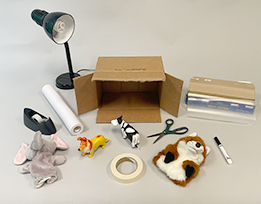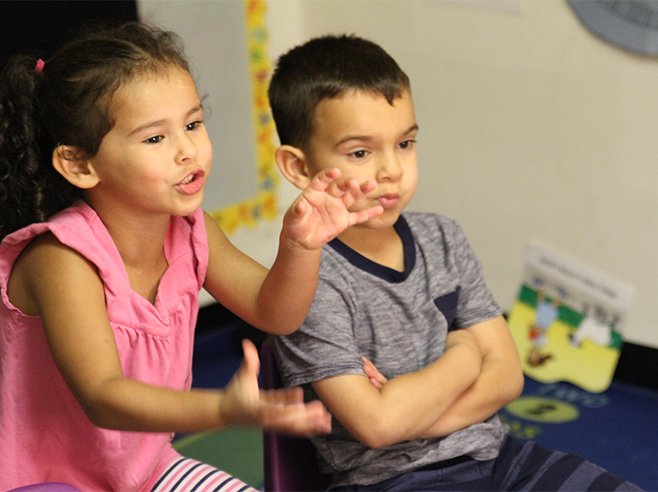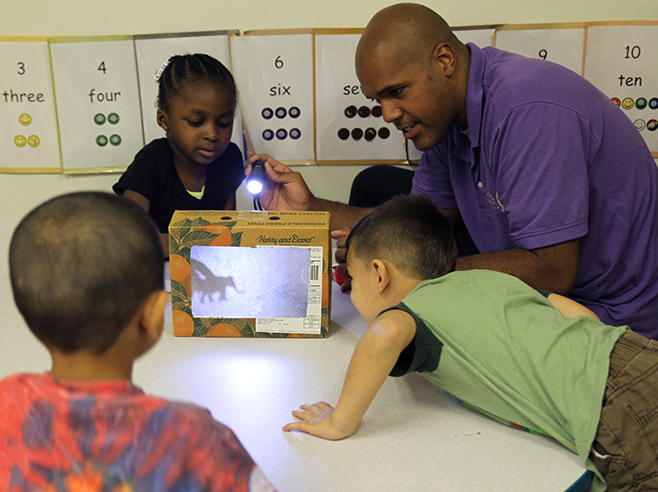Children brainstorm, plan, and design a theater space for performing shadowbox shows in the classroom.
Materials

- Cardboard boxes (medium), 1 for each group
- Chart paper
- A marker
- Scissors
- Tape
- Floor markers, such as masking tape
- Light sources, such as a bright LED lamp with an adjustable head, 1 for each group
- Shadow box theaters (See Preparation section.)
- Shadow objects, such as toy animals, shape cutouts, or handmade puppets
- Shadow surface materials, such as construction paper, wax paper, or chart paper
Preparation
- To make a shadow theater: Turn a box on its side. Cut out the bottom of the box. Leave an edge around the opening. Tape a piece of wax paper or chart paper over the opening. This will be the shadow surface. Children may want to change the surface, so tape lightly to the box edge.
- Find a space in the classroom with a surface large enough to fit the box theater(s) and an area that can accommodate an “audience” for the shadow theater shows.
- Make sure the light source can be easily and safely moved around and repositioned.
- Read through these Tips for Teaching Engineering to help support your young engineers as they become problem solvers:
- Acknowledge all ideas. Every idea is worth trying: That’s a great idea! Let’s try it!
- Allow children to fail or “get stuck.” This is when they get to figure out why their approach did not work and how they can revise it: Why do you think this structure didn’t work? What can you do to change it? Let’s test it!
- Encourage children to share and build on one another’s ideas. This helps them become communicators and collaborators in solving problems: I like how you used child’s idea and added your own idea to it!
Directions: Lesson 6
Guided Small Group
- EXPLORE. Review shadows. Ask children to share an experience they had with making shadows. Have them describe how the shadow was made.
- Identify the want or need. Discuss why you want to create a classroom theater space for performing shadow plays. Draw attention to one of the shadow box theaters. Model making a shadow inside the box so children can see it appear on the surface (chart paper).
- Introduce the idea of designing a shadow theater space. Discuss how to arrange the theater space, and write down ideas. Things to consider include:
- Where the box theater and the light source will go
- A way to block out classroom lights or sunlight from shining in the box
- Where the child making the shadow will stand and where the audience will sit
- Draw attention to the materials you will need:
- Objects that will block light and cast shadows
- Different shadow surface materials that will let some light through
- CREATE. Brainstorm possible solutions. Invite children to share their ideas. Encourage all children to participate. Possible solutions can address:
- A location for the box theater(s), light source, objects, child making the shadows, and audience
- Create your theater space. Put the box theater(s) in position. Find the best location for the child making the shadows and the audience. Use tape to mark the locations on the floor. This will make it easy for children to move in and out of position. Set up the rest of the space.
- IMPROVE. Test the solution. Have children sit and stand in the marked locations. Test the theater space. Encourage children to describe what is working and what is not working. Possible discussion ideas:
- What do you notice?
- Do the shadows fit on the shadow surface?
- Can the audience see the shadow show?
- Are the objects easy for the shadow maker to reach?
- Improve it! If something is not working, revise the design based on the results of the test. Have children discuss:
- Why the design didn’t work and what needs to change
- Whether they can improve the show by moving the audience or the light source
- How they will know if the design is a good one
- How they can reduce ambient/unwanted light entering the space
- Take a picture of the theater space design. Then revise the design to improve it and test it again. Testing multiple iterations will allow more children to participate.
- SHARE. Document the final solution. When you have a successful theater space, tape the final position marks on the floor. Take a picture of the final theater space.
- Communicate. View and discuss the theater space pictures. Possible discussion ideas:
- View a successful design and ask, Did our design create a good theater space? Why or why not?
- View an unsuccessful design and ask, Why didn’t this design work? (for example, too much ambient light, the audience couldn’t see the shadows, and so on) How did we improve it?
- Leave the shadow theater space in place so children can perform small group shadow shows throughout the shadows unit!


